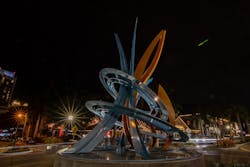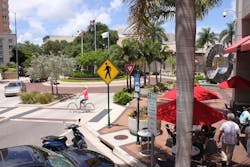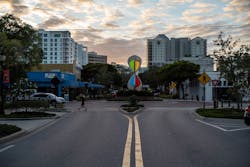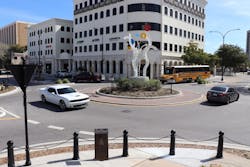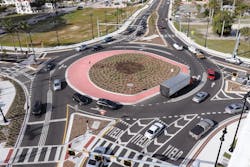A City of Visionaries, Roundabouts, and the Arts
Sarasota, Florida is a city that has long proudly supported the arts.
The city’s vibrant arts scene includes the Ringling College of Art and Design, the famous Ringling Museum, an opera house, a ballet company, and the Sarasota Art Museum. Thanks to visionaries, the City’s Public Art Collection now includes downtown modern roundabouts graced with artworks.
Early on, then Sarasota City Engineer Dennis Daughters, then City Traffic Manager Sam Freija, and current City Engineer Alex Davis Shaw envisioned a downtown made more pedestrian friendly—and even more beautiful—with a collection of modern roundabouts. Today, their vision is coming to fruition.
“We’re interested in the safety of walkability and connectivity to Sarasota Bay,” Downtown Sarasota Condo Association Transportation Committee Chair and Urban Planning Professor Emeritus at the University of Cincinnati Roger Barry said. “The roundabouts help supply that and appear to be extremely successful. I think we’re kind of proud of the fact Sarasota is an art-focused community and the roundabouts are an expression of that.”
Five Points Roundabout—Main Street & Pineapple Avenue
City Engineer Alex Davis Shaw said that back when it was a conventional signalized intersection, “The Five Points intersection was confusing to cars and pedestrians alike. It was a vast expanse of pavement. As part of the city’s goal to make downtown more walkable, this was an intersection that needed improvements. In addition, the city had plans for single-lane and multi-lane roundabouts. We wanted to make intersections safer and more walkable. We wanted to get people comfortable with the concept of driving roundabouts before we constructed the multi-lane roundabouts, so we started with single lane roundabouts."
The Five Points Roundabout was Sarasota’s first downtown roundabout. This lushly landscaped modern roundabout replaced a poorly performing 5-legged intersection traditionally controlled by traffic signals. The roundabout transformed the signalized stop, wait, and go traffic movement into the smooth, silent traffic flow characteristic of modern roundabouts—so much so that the intersection is no longer dominated by motorized traffic. Instead, it has become a people-centric public space where sidewalk diners meet at lunch to talk business and in the evenings chat with friends over dinner and wine—both activities unthinkable in such close proximity to the prior signalized intersection. Downtown economic vitality begins with a pleasant street environment friendly to pedestrians who like to walk, shop, and hang out there daytime and night, making downtown living attractive and prosperous for restaurants. The Five Points Roundabout bookends one end of the downtown Sarasota Main Street shopping and dining district.
The Jon F. Swift Construction company constructed the Five Points Roundabout in 2010 for $1,006,017. The firm had already constructed four complete streets projects in downtown Sarasota which involved fixing utilities below ground and improving pedestrian facilities above ground. “There are obstacles in building roundabouts in downtown Sarasota, one being the project must remain open for pedestrian access,” said Jason Swift, owner and project manager at Jon F. Swift Construction. “We have experience in creating a plan for continuing construction while maintaining daily operations downtown as much as possible, making the businesses and the city happy.”
The good looks, success, and popular acceptance of the Five Points Roundabout set the stage for more modern roundabouts in downtown Sarasota. Two more soon followed, and in 2013 the City Commission made it a requirement that successive roundabouts would include artworks. Since then, the city has built three more roundabouts downtown, all with artworks gracing their central islands.
Funding became available for art in roundabouts when the Sarasota Commission imposed a requirement that if their building permit exceeds $1 million, developers must donate to public art by either allocating 0.5% of their project cost to installing on-site public art or else by contributing that amount to a public arts fund. No tax revenue is tapped.
Sarasota planner David Smith manages the city’s public arts program. He issues the calls to artists that have spurred interest worldwide among sculptors eager to exhibit their work in Sarasota’s downtown modern roundabouts. “Sarasota is known as an arts and culture community in Southwest Florida,” said Smith. “The roundabout artworks add to the aesthetics and beauty of the city. But the roundabouts also help with the movement of traffic and with traffic calming. Each of the roundabouts functions quite well. Traffic moves fairly slowly through them so pedestrians can cross with no issues, so they have really improved the general mobility in the city, whether it’s vehicles or pedestrians.” The City’s Public Arts Committee performs the selections of the winning artworks.
Embracing Our Differences Roundabout—Main Street & Orange Avenue
The Embracing Our Differences Roundabout bookends the other end of the very popular downtown Sarasota Main Street shopping and dining district. It was constructed by Jon F. Swift Construction under a contract with the city for $1,330,433. This busy roundabout also creates a popular people space with day and night sidewalk dining immediately adjacent to the roundabout. Wide sidewalks, angle parking, shade trees, and overhead awnings add up to a complete street friendly to pedestrians, bicyclists, skaters, and patrons young and old.
Blessing Hancock is the sculptor and owner of Skyrim Studio Inc. in Tucson, Arizona. She emphasizes large-scale sculptures in her work. She visited Sarasota before creating the work in order to understand how it would be viewed as the public drives or walks around it.
The 2,500-lb sculpture is made of stainless steel in the shape of a 20-ft tall, upright infinity symbol representing diversity and inclusion. Its red, yellow, blue, and green resin insert panels are the rainbow colors matching the logo colors of Embracing Our Differences, a local organization that promotes diversity through educational initiatives and sponsors an annual art exhibit. Gizmo Art Production of San Francisco assisted in the installation.
Bravo! Roundabout—Ringling Boulevard & Orange Avenue
C-Squared General Contractors Inc. constructed this roundabout under a $875,914 contract with the city. The Bravo! artwork was purchased for $150,000 using Public Art Funds.
The Bravo! artwork in the roundabout central island comprises three separate 18-ft tall sculptures that were joined during the installation process. The sculptures are made of stainless steel and aerospace aluminum and finished with power-coated paint to withstand the elements.
Design services for the roundabout were provided by Sam Schwartz Engineering in Tampa, Florida, with Greg Trim as lead design engineer. Trim has designed more than 100 modern roundabouts, of which more than 40 have been constructed to date. The Bravo! roundabout was made possible at that time because the design was privately funded by a Sarasota resident who wished to see Sarasota’s downtown roundabout aspirations accelerated.
Vehicular traffic traversed the prior, conventional intersection at 35 mph. By design, the bus-friendly modern roundabout caps all vehicle speeds below 20 mph. The signalized prior intersection was awkward and intimidating for pedestrians, who had to walk a single-stage 90-ft crossing. At the new roundabout, pedestrians walk only 14 ft across one lane of approaching traffic to the roundabout splitter island where they can comfortably wait for a safe gap in the slow-moving exiting traffic before walking the 14-ft second stage of the crossing. Careful design made it possible for the roundabout to fit within the constrained urban setting with no need to purchase right of way.
The Florida DOT provided Local Agency Program funding for construction. The roundabout opened in July 2018 “to rave reviews from residents and users” alike, according to Shaw. The roundabout has proven to solve both traffic congestion and concerns for pedestrian safety. An example of context-sensitive design in an urban setting, it won the 2019 Small Projects Award for Engineering Excellence conferred by the Florida Institute of Consulting Engineers.
A Vision for Fruitville Road
Fruitville Road is an east-west four-lane divided highway that once bordered the northern edge of downtown Sarasota. New urban redevelopment in the Rosemary District on the north side of the highway has expanded the borders of downtown northward so Fruitville Road now effectively cuts through downtown. Unfortunately for downtown, the vehicle speeds and 4-ft sidewalks are unsuitable for a livable downtown. City planner Steve Stancel hired the engineering and planning firm of Sam Schwartz Engineering to find a solution. The consultant analyzed the traffic volume and determined Fruitville Road could have very desirable 16-ft sidewalks plus 8-ft buffers between moving traffic and pedestrians that would create room for the shade trees and sidewalk dining necessary for street vitality. These benefits to downtown could be attained by eliminating two of the four travel lanes and replacing three signalized intersections with one-lane modern roundabouts along the most critical half-mile section of Fruitville Road. No purchase of right-of-way would be needed.
The three envisioned roundabouts were not controversial, but the idea of giving up two motorized travel lanes was. Just as with “road diet” proposals elsewhere, the notion can seem unworkable to a public accustomed to having four lanes. Road diets are projects that repurpose a portion of roadway width for non-motorized use such as parking, bike lanes, or wide sidewalks. The Federal Highway Administration strongly advocates road diets as part of its Every Day Counts safety initiative. To help counter public push-back it has sponsored several Peer Exchanges at which practitioners meet for two days to share practical tips and war stories.
The Greater Sarasota Chamber of Commerce and the Rosemary District both strongly supported the Fruitville Road vision of fewer travel lanes and three new modern roundabouts.
A U.S. 41 Roundabout Corridor Vision
U.S. 41 is a typical 4-lane divided highway with landscaped median that carries substantial traffic north and south along the western, bayside edge of downtown Sarasota. The city of Sarasota has long had a vision of U.S. 41 as a multimodal corridor, friendly for users of all modes of travel. That meant the signalized intersections would need to be converted to modern roundabouts with two circulating lanes.
Current FDOT District One Secretary L.K. Nandam is now making Sarasota’s vision for U.S. 41 a reality. The Department engaged extensively experienced roundabout designer Michael Wallwork of Alternate Street Design in Jacksonville, Florida, to design the geometrics that are critical to operation of multi-lane modern roundabouts. Wallwork has designed more than 500 modern roundabouts in the U.S., as well as many in Canada and in his native country of Australia where he was District Traffic Engineer for Melbourne.
FDOT is planning to convert the intersection at U.S. 41 and Gulfstream with an ambitious modern roundabout. The first three U.S. 41 intersections to be converted to two-lane modern roundabouts have been completed at the intersections with Fruitville Road, 10th Street, and 14th Street. Michael Wallwork was instrumental in the design of all three.
The U.S. 41 & Fruitville Road roundabout is novel in that it incorporates double white lines demarking the boundary between circulating lanes with large raised pavement markers placed between the two white lines. The purpose is to discourage cars from changing lanes while allowing trucks to cross the double lines if needed. The Quay development adjacent to the roundabout is funding the public art that will grace the central island. FDOT has just approved the public art selected by the city to occupy the central islands of the roundabouts at 10th Street and 14th Street to the north. All these are multi-lane roundabouts and have Pedestrian Hybrid Beacons at the crosswalks (also known as HAWK beacons or High-Intensity Activated crossWalK beacons). The pedestrian-activated beacons are effective at halting traffic before pedestrians cross on the crosswalk.
Further to the north along U.S. 41 are two more modern roundabouts that have just been designed at the intersections of Myrtle Street and Dr. Martin Luther King Jr. Way, both by Greg Trim of Sam Schwartz Engineering. Construction is slated for the near term. Trim’s design of the roundabout at Dr. MLK Way was challenging because of the strong preference to minimize or eliminate any impact on the gas station/convenience store on the southwest corner, which necessitated special consideration of the critical geometrics of the circulating lanes and central island.
The northeast corner of the U.S. 41 intersection with Dr. MLK Way is also of interest because that is a campus corner of the Ringling College of Art and Design. The new roundabout will be much safer for motorized vehicles and, especially, for Ringling students who cross U.S. 41 by foot and bicycle to access the convenience store.
“Ringling College supports the integration of art into the design of the roundabouts along U.S. 41, reinforcing the cultural distinctiveness of the Sarasota community, and is particularly interested in participating in the design of the art installation for this roundabout," said Ringling College President Dr. Larry R. Thompson.
Further north, FDOT has been considering four more modern roundabouts along a 2-mile section of U.S. 41, including one at the entrance to the University of South Florida Sarasota-Manatee campus. The four roundabouts together with improvements between the roundabouts are estimated to cost $33 million. More than two dozen university campuses around the U.S. have entryway modern roundabouts, most sporting branding such as school names and logos or even school mascot figures.
The City of Sarasota and the Florida DOT are showing how transportation and the arts can work together to create a mobility environment that is both safer and more beautiful.
